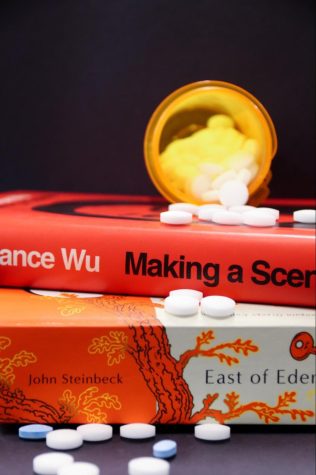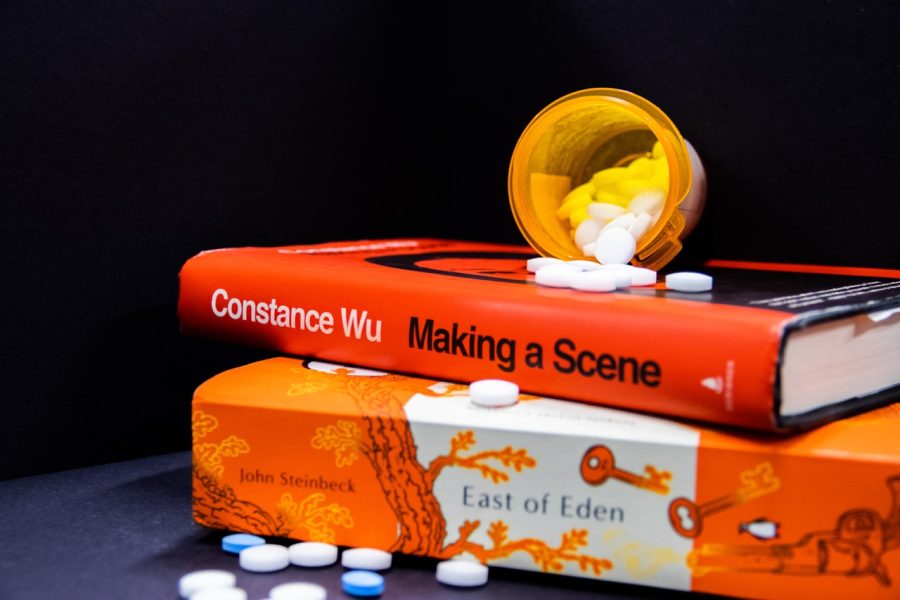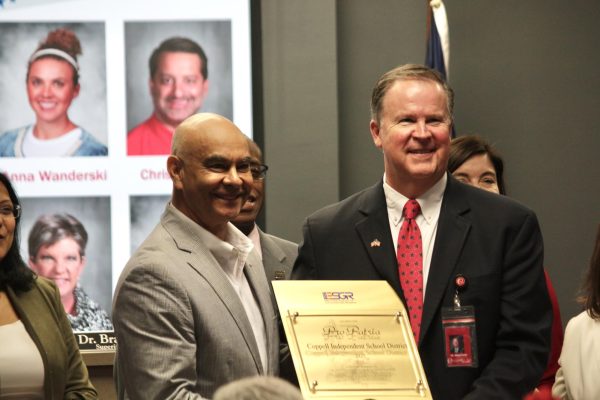The silent killer
Fentanyl crisis closing in on CISD
The fentanyl crisis recently leaked into educational spaces. Coppell High School student resource officers are now training in the use of Narcan, a drug utilized to aid in opioid overdose, in order to protect students from fentanyl and other drug-related crises.
Tracing the swirling letters with a finger on her forearm, Pinkerton Elementary School physical education teacher Colleen Michaelis reminisces on a gift that her late son and Coppell High School alumnus Tommy McClenahan gave her three years prior to his death by an overdose on Aug. 10, 2018.
“He gave me a Tiffany heart bracelet,” Michaelis said. “The letter that went with it said ‘To the most amazing mom ever, from the most annoying son ever. Thought you deserved something a little special this year. Much love mama, Tommy.’”
She runs her fingers once again over the “Much love mama, Tommy” tattoo on her arm.
“That’s in his handwriting,” Michaelis said.
McClenahan was prescribed hydrocodone after a wakeboarding accident at the end of his sophomore year at the University of Mississippi. He was prescribed three refills, which equated to 90 pills.
“He became physically addicted to hydrocodone,” Michaelis said. “I’m sure those kinds of medications at first feel good. But then your body becomes physically addicted to them and your brain gets rewired, one thing leads to the other. Ultimately, Tommy became addicted to heroin, probably a year and a half after that prescription of hydrocodone. For so many, opioid abuse starts with a prescription.”
After coming home from college, McClenahan was highly functioning. However, according to Michaelis, he was not the same Tommy that she knew.
“This whole looking forward to the future, zest for life that Tommy had turned into ‘I’m just chilling, I don’t feel like doing that,’” Michaelis said. “There was a significant difference in mood and sleep patterns. Hiding out, closing the door and not hanging out with family. He came to his dad and myself in January of 2018 and said that he felt like he was living in a cage and he had to get help.”
McClenahan checked into the Recovery Unplugged addiction treatment center in Austin. After leaving the rehabilitation center, he moved into a house with a friend and began working for Vans and was in recovery for seven months.
However, McClenahan relapsed and died on Aug. 10, 2018.
“In July, he said ‘Mom, I feel so good. I’m not even taking allergy medicine,’” Michaelis said. “The air feels good, everything feels good.’ He seemed very happy. Unfortunately, relapse is a five second decision. He was the eighth CHS graduate to die of drug related deaths that year. We used to say, ‘Don’t take those drugs because you might become addicted’ or ‘Don’t take those drugs because your life might become unmanageable.’ But now it’s like, ‘Don’t take those drugs, because you’re not going to wake up tomorrow morning.’ It’s really scary.”
At the top of the toxicology report was fentanyl. Although it ultimately caused his death, McClenahan did not knowingly consume the substance.
Fentanyl is a synthetic opioid about 50 to 100 times more potent than morphine that is typically used as an anesthetic and for pain relief. In recent years, however, traces of fentanyl have made its way into other drugs sold on the streets by dealers, which has ultimately resulted in a spike in deaths caused by overdoses.

(Shrayes Gunna)
“Tommy was a rock-star lacrosse player,” Michaelis said. “He had 41 Division I scholarship offers and had everything going for him. How society measures success as a high school student, Tommy had it all. We let a lot of that greatness cloud our vision in terms of consequences for things that started when he was in high school. He was smoking a little pot, and I was like, it’s not a big deal because his grades are still really good. He got into a little trouble with the police, nothing serious but, you know, hire lawyers and get the record expunged. At the time, he was committed to Providence College for lacrosse and we were doing anything to have him keep his greatness and get out of Coppell.”
According to Psychology Today and Michaelis, the rate of teenagers risk partaking in drug use, binge drinking and stealing is higher in high income areas compared to low income areas.
Teenagers of affluent parents are expected to excel in school, in extracurricular activities and in social situations. They feel immense pressure that plays a part in substance use, depression and delinquency.
“It’s like when you tell a 3-year-old not to talk to strangers and they conjure up this image of a black-cloaked man who’s a stranger, like a monster,” Michaelis said. “We know strangers aren’t monsters. That’s the way people in Coppell think about the kids who are doing drugs. They aren’t involved in sports, they don’t have any friends, they’re not involved in extracurricular activities, teachers don’t like them, their grades are bad. All of those ideas keep us in denial, it enables us to say, ‘Those aren’t our kids.’ But they are our kids. Our kids are raised, no matter what focus you’re on, to be the best of the best. Kids grow up with that drive. It’s not like they lose that drive when they start drinking and doing drugs.”
According to Michaelis, the day that Tommy died was the first day in months where he was not answering her text messages. Feeling a pit form in her stomach, she began calling her husband [James McClenahan] and son [Ben McClenahan]. After hearing nothing back, she received a phone call from her husband telling her to prepare for the worst news.
“I knew, realistically, that there were three options,” Michaelis said. “It was going to be a miracle, and he was going to be great and do great. Or, he was going to end up in jail or he was going to die.”
According to the National Institute of Drug Abuse, genetics play a large role in addiction. Family studies that include identical twins, fraternal twins, adoptees and siblings suggest that as much as half of a person’s risk of becoming addicted to nicotine, alcohol or other drugs depends on their genetic makeup.
“My brother [Jim Maywalt] got sober when he was 23,” Michaelis said. “He’s super successful in New York City. He’s got a regular job and he’s a stand up comedian. He’s got a beautiful daughter and a beautiful wife and all this. Why would you tell your kids about the mess that he was from 17 to 23, when he’s doing so great now? Because we don’t want them to think that of Uncle Jimmy. Truthfully, we should have told them those stories. When he was in treatment, I said to myself upfront: if something awful happens to him, I am going to speak out about this. If it goes down that road, I’m going to start speaking out.”
The crisis in nearby districts
According to the Centers for Disease Control and Prevention, in 2021 alone, 107,375 people in the United States died of either drug overdoses or drug poisoning. Of those deaths, 67 percent involved synthetic opioids like fentanyl.
According to provisional data from the Texas Department of State Health Services, fentanyl related deaths have increased among Texans by more than 500 percent since 2019.
In the past few months, the synthetic opioid has found its way into the heart of North Texas: the Dallas-Fort Worth metro area.
In February, nine students at three schools in Carrollton-Farmers Branch ISD suffered 10 overdoses from fentanyl. Three were fatal.
The first instance of fentanyl in a Carrollton campus was in October 2022. Immediately after, Narcan, a brand of Naloxone which is a medication used to reverse an opioid overdose, was put in all CFBISD schools.
The three main dealers, Luis Eduardo Navarrete, Magaly Mejia Cano and Jason Xavier Villanueva, who supplied these drugs to the students, had allegedly dealt fake Percocet and Oxycontin pills, both known to treat severe pain, laced with fentanyl to multiple juvenile drug dealers. These children then sold the drugs to their fellow students at school.

“To deal fentanyl is to knowingly imperil lives; to deal fentanyl to minors — naive middle and high school students — is to shatter futures,” U.S. Attorney Leigha Simonton said in a press release. “These defendants’ alleged actions are simply despicable. We can never replace the three teenagers whose lives were lost, nor can we heal the psychological scars of those who survived their overdoses. But we can take action to ensure these defendants are never allowed to hand a pill to a child again.”
The dealers were arrested and indicted on a count of conspiracy to distribute a controlled substance.
According to a U.S. Department of Justice press conference, oftentimes, illicit prescription pills like Oxycontin and Percocet that are laced with fentanyl look similar to legitimate prescriptions, posing a greater threat. These pills are referred to as “M30s,” “blues,” “perks,” “yerks,” “china girls” or “TNT.”
One of the nine students was a 14-year-old girl who overdosed twice and was left temporarily paralyzed.
Another Carrollton drug dealer, Donovan Jude Andrews, capitalized on the arrest of the first two dealers to entice younger buyers to purchase even more fentanyl. According to a press release from the DOJ, Andrews posted under the Instagram handle “deegetbandz_3x,” stating that Navarrete and Cano ‘took all the ATTENTION’ from law enforcement and divulged that he was selling M30 pills for $10 apiece.”
Shortly after, the 14-year-old girl who suffered from a fentanyl overdose admitted to purchasing five M30 pills from the individual who used the “deegetbandz_3x” Instagram account. An 18-year-old girl from Hebron High School admitted to doing the same.
In response, Carrollton ISD hosted a School Health Advisory Council (SHAC) meeting to address the fentanyl crisis.
“I love your kiddos, I love them dearly,” R.L Turner High School school resource officer Nik Stefanovic said at the meeting. “This is a nationwide problem, but today it’s our problem. Me, my chief, the police and my sergeant, we are all working very hard to solve this problem.”
But the crisis doesn’t just end at Carrollton ISD.
In February, Plano Senior High School junior Sienna Vaughn died on the 19th from fentanyl poisoning. According to her memorial website, she took a pill from her friend that she thought was Percocet, a painkiller she believed would help her relax.
“I walked up to her room, knocked on the door… she didn’t answer, so I opened the door, and I found her and her friend laying on the bed,” Vaughn’s mother, Stephanie, said in an interview with FOX News. “Her friend was making this weird gurgling noise and I saw Sienna. She was just so pale. Her lips were already turning blue. I immediately said, ‘Call 911, call 911.’ I jumped over her friend. I tried to do a couple compressions on the bed, and it wasn’t working, so I picked her up, put her on the floor and I just started doing CPR.”
The medics rushed Sienna and her friend to the hospital, but only her friend survived.
“It breaks my heart,” CHS Principal Laura Springer said. “It makes me scared to death honestly. I’m not stupid to think that our kids don’t have access to that kind of stuff because we’ve got money here and we love to have our free time filled with things we shouldn’t be doing. My terrified fear is for one of our kids to get a hold of it and we lose them. I know that we’re going to need to ramp up as a city if it’s happening in Carrollton-Farmers Branch, because we’re right next door. It doesn’t take long to figure out ‘I need to get into Coppell and I need to get into those kids.’”
In April, fentanyl laced pills were found at CHS.
Hitting close to home
The tip of a pencil.
That is the amount of fentanyl that, according to Coppell Police Chief Danny Barton, is a lethal dose.
Earlier this year, an 18-year-old in Coppell fell victim to the crisis. The pill that he ingested appeared to be Oxycontin, but killed him instantly due to the dose of fentanyl.
Twenty-three days later, a 21-year-old overdosed on fentanyl.
Coppell residents have been connected to the supplying of fentanyl.
Barton stated that according to Coppell Fire Chief Kevin Richardson, there have been 11 overdoses this year, 10 of which required the use of Narcan.
But the issue has not just hit Coppell. Recently, the Coppell police department had to remove fentanyl pills from the CHS campus.
CHS AP Literature and Composition and Graphic Novels teacher Alexander Holmes found a small plastic bag with two pills outside the C hall upstairs bathroom. At a school fentanyl awareness assembly delivered to all classes on April 14, Holmes was made aware that the two pills were, in fact, laced with fentanyl during the senior presentation.
“I got shaky, honestly,” Holmes said. “If you know me and you were watching me in that moment, you could definitely see my jaw tensed up just because it’s wild to think about. We very much exist in a bubble and I don’t think that bubble’s been popped by any means, but I wasn’t ready for it to hit that close to home. Even though these things are really, really close, I was still very surprised to hear that such a dangerous thing was just right there, out in the open.”

During the senior assembly, CHS student resource officer Reggie Walker credited Holmes for his actions that likely saved the lives of CHS students who could potentially have happened upon the pills and let curiosity overtake them.
“I’m very happy that whoever was planning on buying or selling those pills didn’t get that to happen,” Holmes said. “I am eternally grateful for that and I hope that maybe I did save a life. I’m the guy who appreciates heroes; I never imagined myself to be that person who saves someone, I’m still processing that. It’s a weird thing to think about but I’m just hoping that whoever could be involved or was involved is still safe to this day, because obviously, this is a problem that will persist.”
CISD campus SROs are training in the use of Narcan, in case it becomes necessary at a school facility. Additionally, Coppell is actively engaged in a mission to educate the community about the crisis and is taking preventive measures against future overdoses. The city is utilizing funds to create citywide advertisements that aim to foster a more informed environment.
“I don’t want anyone in Coppell to not know this is happening,” Barton said on April 11 at a Coppell City Council meeting. “I want everyone to take this seriously. This could be your kid. None of us think it’s going to be our kid. But again, these are accidental overdoses so we have to educate.”
For Springer, the crisis is all too familiar for her.
In 2019, Coppell was confronted with a heroin issue when the Han Gil Hotel, located just 19 minutes away from CHS, became a haven for drug deals as hotel owners allegedly allowed drug dealers to operate in rooms in exchange for payment.
After losing several students to overdoses, Springer left CHS and became principal at Coppell Middle School East to address the issue while students were younger. But now, she recognizes the grave danger students (that she often refers to as her own kids) are in, considering fentanyl is 50 times more deadly than heroin.
“Drugs have been a part of society since the beginning of time,” Springer said. “The difference is in this day and age, they are making drugs mixed with different things. You’re buying something from somebody, you never know what you’re going to get from a vape pen all the way up. You don’t know what’s going to be in it. They’re using a lot of synthetic drugs that kids are getting a hold of, it’s making them be addicted quicker and they’re putting higher doses. Through those synthetics, it takes up the dosage and the effects that’s going to happen so that you get addicted quicker. I want kids to hear from us this is serious, this is not something you play with and come back from.”
With the fentanyl student assembly and the preventative measures that are to be implemented, Springer hopes to be able to reach students to make them aware of the deadliness of just one pill. Even if they have never touched a drug before in their life, one tiny dose of fentanyl could kill them, and even if they have experience with drugs, that does not make them immune to the fatality of fentanyl-laced pills.
“We may not be able to get to you in time to save your life,” Springer said. “You’re just a kid, you still have your whole life ahead of you. There’s nothing worth wasting your life over to get a high.”
Follow Angelina (@angelinaliiu), Sri (@sriachanta_), Manasa (@Manasa_Mohan_7) and @CHSCampusNews on Twitter

Angelina is a senior and the Executive Editor-in-Chief of The Sidekick. In her free time, she likes to listen to sad music, spend too much of her paycheck...

Sri Achanta is a senior and the executive editor-and-chief of The Sidekick. She finds joy in finding narratives within conversations to create compelling...

Manasa is a senior and the Executive Editorial Page Editor for The Sidekick. You can most likely find her watching a movie, hanging out with friends, watching...

Shrayes is a senior and a staff writer and photographer of The Sidekick. No matter the situation, you can find him listening to and analyzing music, delving...















Pramika Kadari • Apr 6, 2024 at 1:00 pm
Wow, this is such a powerful story! It reminds me of the Han Gil Hotel story that Anthony wrote years ago, which I see is hyperlinked in this one. Thank you CSM for covering such important topics with journalistic excellence.
Anthony • Apr 6, 2024 at 12:59 pm
Wow, thank you for shedding light on this subject. I had no idea this issue hit so close to home.